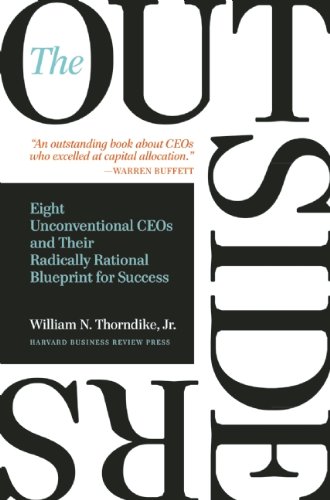

This article is an excerpt from the Shortform summary of "The Outsiders" by William N. Thorndike, Jr. Shortform has the world's best summaries of books you should be reading.
Like this article? Sign up for a free trial here .
It’s a big question: who are the best CEOs of all time? What makes them the best?
Some big names come to mind when we consider the best CEOs of all time, including old business giants who built some of the biggest companies we know today. While there were undoubtedly many great CEOs, William Thorndike poses in The Outsiders, that the most successful CEOs are the ones that were the most profitable and grew their companies by following unorthodox business strategies. Read about the 8 best CEO’s of all time and why being an “outsider” makes them great CEOs.
The Best CEOs of All Time: Why Being an Outsider Works
If you’re asked about the best CEOs of all time, one name might naturally come to mind: Jack Welch. Sure, he achieved great financial return and is trumpeted by the press. But is Jack Welch really the greatest CEO of the century? According to the author of The Outsiders, no—not even close. There are CEOs who performed better during worse economic periods.
According to the author of The Outsiders, there are three things that make great CEOs, and things that the Outsiders CEOs had in common:
- Their approach to capital allocation
- Their management practices
- Their personality traits
In all three areas, outsider CEOs departed from common wisdom about how to operate a company and behave as a CEO.
This departure from conventional thinking makes logical sense. By doing the same things as everyone else, you’re restricted to average performance. You need to do unorthodox things to get unorthodox results. This lead to the author to create a list of the best CEOs of all time.
1. Tom Murphy: Capital Cities Broadcasting
Capital Cities Broadcasting was a media company owning television stations, radio stations, and print publications. Outsider CEO Tom Murphy was CEO from 1966 to 1996, and is undoubtedly one of the best CEOs of all time.
In 1966, the market capitalization of Capital Cities was 6% that of CBS, the dominant media business in the country.
By 1996, when Capital Cities sold to Disney, it had rocketed past CBS and was now worth three times as much as CBS. It had acquired media giant ABC, which was dubbed by the press as akin to a “minnow swallowing a whale.” Relative to CBS, Capital Cities had grown nearly 50 times as much in the same period.
The strategy was simple and repeatable: buy media properties with attractive economics, improve operations to generate more cash, and use the cash to buy more media properties. Capital Cities had a management playbook that made it very effective at increasing revenue and cutting costs at its newly acquired companies. This created a “perpetual motion machine for returns.”
From 1966 to 1996, Capital Cities showed a 19.9% annual return rate, compared to the 10.1% for the S&P 500 and 13.2% return for leading media companies.
$1 invested at the beginning would have been worth $204 by 1996. This outperformed the S&P by 16.7 times, and his peers by almost 4 times.
2. Henry Singleton: Teledyne
Next on the list of greatest CEOs of all time is Henry Singleton. Teledyne is an industrial conglomerate founded in 1960, currently involved in businesses ranging from aerospace electronics to digital imaging.
Founder Henry Singleton served as CEO from 1960 to 1986, taking it through three phases with very different activities:
- Rapid expansion of the conglomerate through acquisitions
- Aggressively buying back shares with the company’s free cash flow
- Spinning out its subsidiaries when performance began stagnating
From 1963 to 1990, Teledyne showed a 20.4% annual return rate, compared to 11.6% for the S&P 500 and 11.6% for major conglomerates.
$1 invested at the beginning would have been worth $181 by 1990. This outperformed the S&P by 12 times, and his peers by nearly 9 times.
3. Bill Anders: General Dynamics
General Dynamics is an aerospace and defense corporation. After the end of the Cold War, it and many other defense companies faced a large contraction of spending as US national defense priorities shifted. Incoming CEO Bill Anders successfully led a turnaround that made General Dynamics the industry’s profit leader, instilling fundamentals that continue to this day.
From 1991 to 2008, General Dynamics showed a 23.3% annual return rate, compared to 8.9% for the S&P 500 and 17.6% for major conglomerates.
$1 invested at the beginning would have been worth $30 by 2008. This outperformed the S&P by 6.7 times, and its peers by 1.8 times, proving Anders’ capability his role as one of the nation’s greatest CEOs of all time.
4. John Malone: Tele-Communications Inc. (TCI)
Tele-Communications Inc. (TCI) was a cable television provider founded in 1958. It grew to be the largest cable company in the country, owning both cable providers and content programming. It was acquired by AT&T in 1999 for $43.5 billion in stock and, through a series of transactions, would ultimately become Comcast.
As CEO from 1972 to 1991, John Malone pursued a virtuous cycle strategy—grow subscriber count through acquisitions of cable providers, which would give scale to negotiate lower fees with content providers, which would make acquisitions of cable companies further cheaper.
From 1973 to 1998, Teledyne showed a 30.3% annual return rate, compared to 14.3% for the S&P 500 and 20.4% for public cable companies.
$1 invested at the beginning would have been worth $900 by 1998. This outperformed the S&P by 40 times, and his peers by 5 times.
5. Katherine Graham: The Washington Post
The Washington Post was owned by Eugene Meyer, whose daughter was Katharine Graham. Her husband, Philip Graham, was hired by Meyer to lead the Washington Post from 1946 to 1963. However, Philip committed suicide in 1963, and Katharine was expected to take over management and become one of the most successful CEOs.
An inexperienced executive, Katharine hadn’t worked for 20 years when she took the CEO role. But through wise decisions around both editorial and business, the help of strong executives, and a key advisor by the name of Warren Buffett, she led the Post to be the most successful newspaper company of its class.
From 1971 to 1993, the Washington Post Company showed a 22.3% annual return rate, compared to 7.4% for the S&P 500 and 12.4% for public newspapers.
$1 invested at the beginning would have been worth $89 by the end. This outperformed the S&P by 18 times, and her peers by six times.
6. Bill Stiritz: Ralston Purina
Ralston Purina was a consumer packaged goods company producing commercial animal feed, consumer pet food, and human foods. When Stiritz joined as CEO in 1981, Ralston had a muddled focus (having purchased a hockey team and ski resort) and a stagnant stock price. Stiritz revitalized the company with discipline, divesting unprofitable business units and acquiring new genuinely synergistic businesses. In 2001, Ralston merged with Nestle in a transaction worth $10.4 billion. This is considered a defining move by one of the greatest CEOs of all time.
From 1981 to 2001, Ralston showed a 20.0% annual return rate, compared to 14.7% for the S&P 500 and 17.7% for peer companies.
$1 invested at the beginning would have been worth $38 by 2001. This outperformed the S&P by 2.5 times, and his peers by 50%.
7. Dick Smith: General Cinema
General Cinema was a movie theater company founded in 1922 by Phillip Smith, who expanded drive-in theaters throughout New England and the Midwest. When he died in 1962, his son Dick Smith took over as CEO. Dick further expanded the company’s theater locations, then diversified into unrelated businesses such as beverage bottling and retail. While diversifying acquisitions often end in failure, Smith executed them with finesse, leading to fantastic performance when the company’s divisions were sold at premium prices in the 2000s, a move that shows Smith as one of the best CEOs of all time.
From 1962 to 2005, General Cinema (and its spinoffs) showed a 16.1% annual return rate, compared to 9% for the S&P 500 and 9.8% for GE.
$1 invested at the beginning would have been worth $684 by the end. This outperformed the S&P by 15.8 times, and GE by 11.4 times.
8. Warren Buffett: Berkshire Hathaway
Saving the best for last, the author ends with Warren Buffett’s staggering returns over the 50-plus year history of Berkshire Hathaway. Starting with buying a textile company in 1965, Buffett grew Berkshire Hathaway into one of the world’s largest companies. Of course, Buffett consistently is named one of the best CEOs of all time.
Over the years, Buffett excelled in all manners of investments—in both public and private companies, with ownership of both minority and total stakes. He famously made use of insurance float to fund investments in higher-return companies, held a small basket of companies for very long periods of time, and acted aggressively when everyone else was ducking for fear.
From 1965 to 2011, Berkshire Hathaway showed a 20.7% annual return rate, compared to 9.3% for the S&P 500.
$1 invested at the beginning would have been worth $6,265 by 2011. This outperformed the S&P by a staggering 100 times.
The Outsider CEO’s may have operated companies with different business goals but each one applied their own unorthodox strategies to growing their businesses and making profits. Considering their performance, there’s no doubt that these “outsiders” were the best CEOs of all time.

———End of Preview———
Like what you just read? Read the rest of the world's best summary of William N. Thorndike, Jr's "The Outsiders" at Shortform .
Here's what you'll find in our full The Outsiders summary :
- What great CEOs like Warren Buffett do that average CEOs don't
- How to master the art of capital allocation
- How to be a great manager that your team is excited to work with






